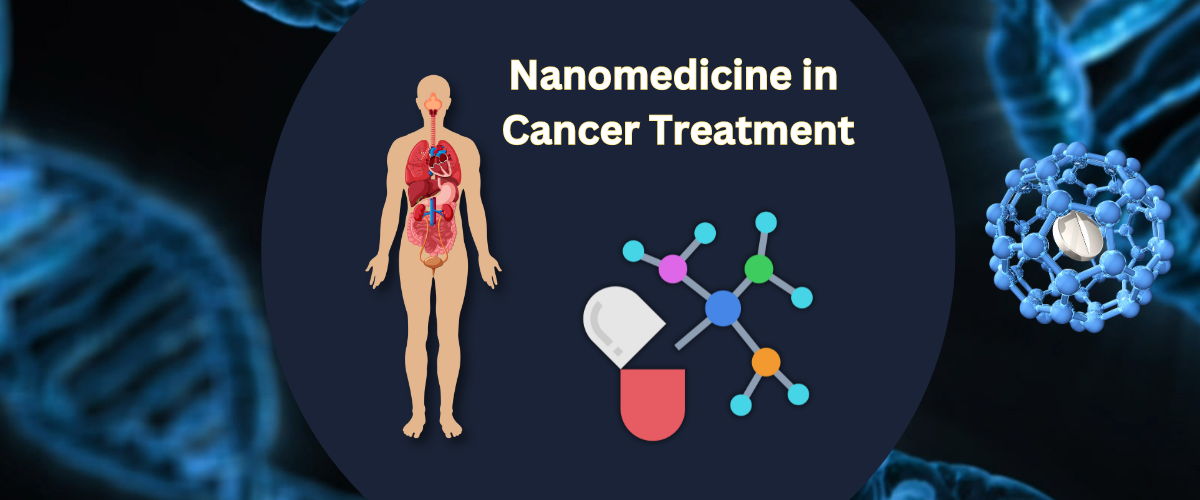BLOG
Nanomedicine in Cancer Treatment: A Revolutionary Approach

Cancer treatment has come a long way, but the quest for more effective and less invasive therapies continues. One of the most exciting advancements in recent years is the emergence of nanomedicine. This innovative field uses nanotechnology to improve cancer treatment, offering new hope for patients and clinicians alike. In this blog, we'll explore how nanomedicine is transforming the landscape of cancer care, its benefits, challenges, and the future it holds.
What is Nanomedicine?
Nanomedicine involves the use of nanotechnology—the science of manipulating matter at the molecular or atomic scale (1 to 100 nanometers)—to develop new medical applications. In the context of cancer treatment, nanomedicine focuses on designing nanoparticles that can target cancer cells specifically, deliver drugs more efficiently, and minimize side effects.
The Promise of Nanomedicine in Cancer Treatment
1. Targeted Drug Delivery
One of the most significant advantages of nanomedicine is its ability to deliver drugs directly to cancer cells, sparing healthy tissues from damage. Traditional chemotherapy often affects both cancerous and healthy cells, leading to severe side effects. Nanoparticles can be engineered to recognize and bind to specific markers on cancer cells, ensuring that drugs are delivered precisely where needed. This targeted approach increases the efficacy of the treatment and reduces systemic toxicity.
2. Enhanced Imaging and Diagnosis
Early and accurate diagnosis is crucial for successful cancer treatment. Nanomedicine offers improved imaging techniques through the use of nanoparticles that enhance contrast in imaging scans. For instance, magnetic nanoparticles can be used in magnetic resonance imaging (MRI) to provide clearer and more detailed images of tumors. Quantum dots, another type of nanoparticle, emit light at different wavelengths and can be used in fluorescent imaging to highlight cancerous cells with high precision.
3. Overcoming Drug Resistance
Drug resistance is a significant challenge in cancer treatment. Cancer cells can develop resistance to chemotherapy drugs, making treatment less effective. Nanomedicine has the potential to overcome this problem by using nanoparticles to deliver drugs in combination or in novel formulations that can bypass resistance mechanisms. Additionally, nanoparticles can be engineered to release drugs in a controlled manner, providing a sustained therapeutic effect and reducing the likelihood of resistance.
4. Personalized Medicine
Nanomedicine supports the trend towards personalized medicine—treatments tailored to the individual characteristics of each patient. By analyzing the specific genetic and molecular profile of a patient's cancer, nanoparticles can be designed to target the unique features of their tumor. This approach allows for more precise and effective treatment strategies, potentially improving outcomes and minimizing side effects.
Current Applications and Research
Nanomedicine is already making strides in clinical practice. Several nanomedicines have been approved for use in cancer treatment, and many more are in various stages of clinical trials. For example, Doxil, a liposomal formulation of the chemotherapy drug doxorubicin, uses lipid-based nanoparticles to enhance drug delivery and reduce side effects. Another notable example is Abraxane, a nanoparticle albumin-bound formulation of paclitaxel, which has shown improved efficacy and reduced side effects compared to conventional paclitaxel.
Research is also exploring the use of nanoparticles for immunotherapy, a treatment that harnesses the body's immune system to fight cancer. Nanoparticles can be designed to deliver immune-modulating agents or vaccines specifically to the tumor microenvironment, enhancing the immune response against cancer cells.
Challenges and Considerations
Despite the promising potential of nanomedicine, several challenges need to be addressed before it becomes a mainstream treatment option:
1. Safety and Toxicity
The safety of nanoparticles is a critical concern. While they offer targeted delivery and reduced side effects, there is still limited knowledge about their long-term effects on the body. Comprehensive studies are needed to evaluate the biocompatibility and potential toxicity of nanoparticles.
2. Manufacturing and Scale-Up
The production of nanoparticles must be consistent and scalable to meet clinical demands. Developing cost-effective manufacturing processes that maintain the quality and efficacy of nanoparticles is essential for their widespread adoption.
3. Regulatory and Ethical Issues
The regulatory framework for nanomedicine is still evolving. Ensuring that nanoparticles meet stringent safety and efficacy standards is crucial for their approval and use in clinical settings. Additionally, ethical considerations related to the use of advanced nanotechnology in medicine must be addressed.
The Future of Nanomedicine in Cancer Treatment
The future of nanomedicine in cancer treatment looks promising. Ongoing research and technological advancements are likely to lead to new and improved nanomedicines with enhanced targeting, efficacy, and safety profiles. Collaborative efforts between researchers, clinicians, and regulatory bodies will be essential to overcome existing challenges and bring these innovations to patients.
As we look ahead, nanomedicine has the potential to revolutionize cancer treatment by offering more precise, effective, and personalized therapies. While there is still much to learn and achieve, the progress made so far is a testament to the power of combining science and technology to tackle one of the most challenging medical conditions.
conclusion
nanomedicine represents a new frontier in cancer treatment. By leveraging the unique properties of nanoparticles, this innovative approach promises to improve outcomes, reduce side effects, and personalize therapy for cancer patients. As research continues and technology advances, nanomedicine is poised to play a pivotal role in the future of cancer care.
FAQ about Nanomedicine in Cancer Treatment
1. What is nanomedicine?
Nanomedicine is a branch of medicine that utilizes nanotechnology to develop new diagnostic, therapeutic, and imaging techniques. It involves manipulating matter at the nanoscale (1 to 100 nanometers) to create nanoparticles that can interact with biological systems, offering innovative approaches to treating diseases, including cancer.
2. How does nanomedicine improve cancer treatment?
Nanomedicine enhances cancer treatment through several key mechanisms:
- Targeted Drug Delivery: Nanoparticles can be engineered to deliver drugs specifically to cancer cells, reducing damage to healthy tissues and minimizing side effects.
- Enhanced Imaging: Nanoparticles improve imaging techniques, providing clearer and more detailed images of tumors.
- Overcoming Drug Resistance: Nanoparticles can help bypass or overcome mechanisms of drug resistance in cancer cells.
- Personalized Medicine: Nanomedicine allows for the development of treatments tailored to the unique genetic and molecular profile of each patient’s cancer.
3. What are some examples of nanomedicines currently used in cancer treatment?
Some examples of nanomedicines include:
- Doxil: A liposomal formulation of doxorubicin that enhances drug delivery and reduces side effects.
- Abraxane: A nanoparticle albumin-bound formulation of paclitaxel that improves efficacy and reduces side effects compared to conventional paclitaxel.
4. Are nanoparticles safe to use in medicine?
The safety of nanoparticles is an ongoing area of research. While they offer targeted delivery and reduced side effects, their long-term effects on the body are not fully understood. Researchers are conducting extensive studies to assess the biocompatibility and potential toxicity of nanoparticles to ensure their safety for clinical use.
5. What challenges does nanomedicine face?
Nanomedicine faces several challenges:
- Safety and Toxicity: Understanding the long-term effects of nanoparticles on the body is crucial.
- Manufacturing and Scale-Up: Developing cost-effective and consistent manufacturing processes is essential for widespread use.
- Regulatory and Ethical Issues: Ensuring nanoparticles meet safety and efficacy standards and addressing ethical considerations are important for their clinical adoption.
6. How does nanomedicine differ from traditional cancer treatments?
Nanomedicine differs from traditional cancer treatments in its approach to drug delivery and targeting. Traditional treatments like chemotherapy affect both cancerous and healthy cells, often leading to severe side effects. Nanomedicine uses nanoparticles to specifically target cancer cells, enhancing treatment efficacy and reducing side effects.
7. Can nanomedicine be used in combination with other cancer therapies?
Yes, nanomedicine can be used in combination with other cancer therapies. For example, nanoparticles can deliver chemotherapy drugs, immunotherapy agents, or targeted therapies, potentially improving their effectiveness and reducing side effects. Researchers are exploring various combinations to optimize treatment outcomes.
8. What is the future of nanomedicine in cancer treatment?
The future of nanomedicine in cancer treatment is promising. Ongoing research and technological advancements are likely to lead to more effective and safer nanomedicines. As understanding of nanoparticle interactions with biological systems grows, nanomedicine is expected to play an increasingly significant role in personalized cancer care.
9. How can patients learn more about nanomedicine and its potential benefits?
Patients interested in nanomedicine can speak with their oncologists or healthcare providers for more information. Additionally, they can explore reputable medical and research websites, attend cancer support groups, or consult with specialists who are knowledgeable about nanomedicine and its applications in cancer treatment.
10. Where can I find clinical trials related to nanomedicine in cancer treatment?
Clinical trials involving nanomedicine can be found on clinical trial registries such as ClinicalTrials.gov or through academic research institutions and cancer centers. Patients interested in participating in trials should consult their healthcare providers to explore available options and determine eligibility.
-
 Azadine 100mg Injection
Azadine 100mg Injection
₹4,780.50Original price was: ₹4,780.50.₹3,610.00Current price is: ₹3,610.00. -
 Azadine O 300mg Tablet
Azadine O 300mg Tablet
₹24,000.00Original price was: ₹24,000.00.₹14,500.00Current price is: ₹14,500.00. -
 Azatend O 300mg Tablet
Azatend O 300mg Tablet
₹23,995.00Original price was: ₹23,995.00.₹15,500.00Current price is: ₹15,500.00.
How to Choose the Right Oncology Pharmacy: A Comprehensive Guide
-
Posted by
admin
- 0 comments
The Evolution of Cancer Treatments: A Journey from Ancient Remedies to Modern Innovations
-
Posted by
admin
- 0 comments
Top 5 Cancer Hospitals in Andhra Pradesh
-
Posted by
admin
- 0 comments
How to Access Experimental Cancer Drugs Through Clinical Trials
-
Posted by
admin
- 0 comments
How Antioxidants Can Help in Cancer Prevention
-
Posted by
admin
- 0 comments
Top 5 Cancer Hospitals in Sikkim
-
Posted by
admin
- 0 comments
The Importance of Cancer Survivorship Programs
-
Posted by
admin
- 0 comments
Immunomodulatory Drugs: Their Benefits and Side Effects
-
Posted by
admin
- 0 comments
8 Ways Orthopedic Support Enhances Senior Comfort & Mobility
-
Posted by
admin
- 0 comments
Top 5 Cancer Hospitals in Rajasthan
-
Posted by
Rahul Rai
- 0 comments
Top 5 Cancer Hospitals in South India: Comprehensive Care and Cutting-Edge Treatment
-
Posted by
admin
- 0 comments
Prostate Cancer – Causes, Symptoms, and Treatment in India
-
Posted by
admin
- 0 comments













